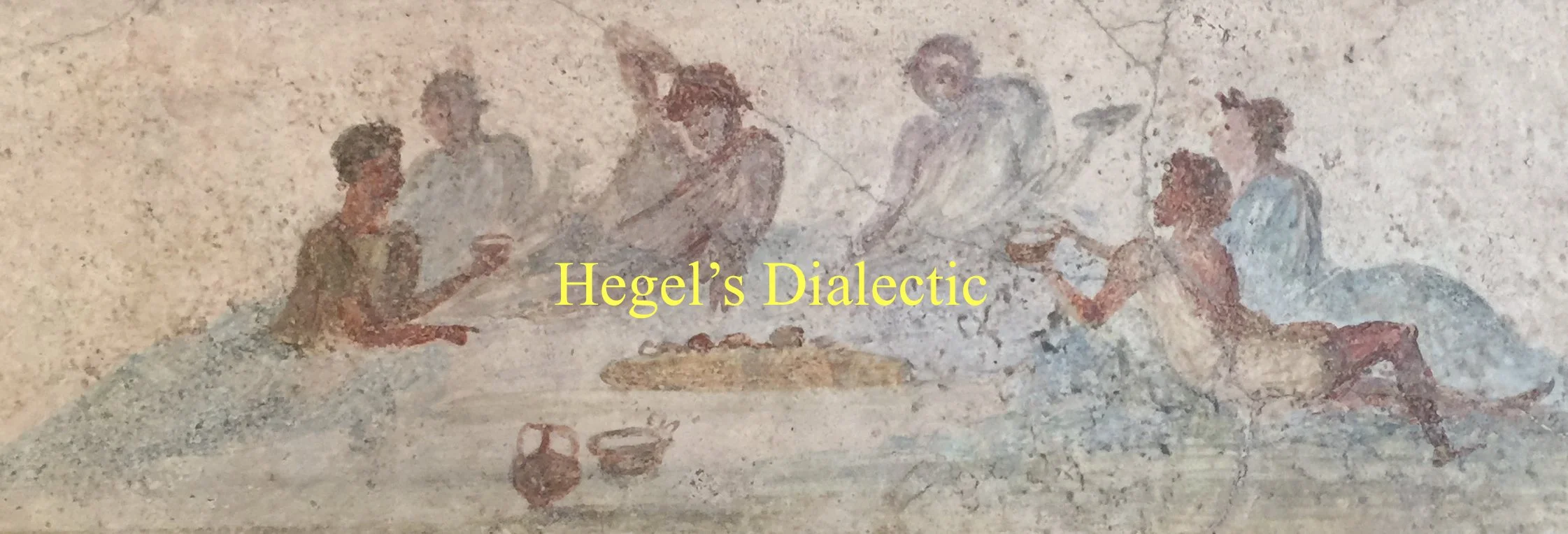Gospel & Universe ❤️ Three Little Words
Hegel’s Dialectic
The Daoist notion of suspension — which Zhuangzi sees in terms of yin & yang and the never-ending forms of dispute — also has much in common with Hegel’s dialectic, in which the two sides of any situation are seen in terms of one side naturally implying the other. Hegel uses the verb aufheben or to sublate in describing the way one side is cancelled out and yet also retained. One can also use the verb to resolve. (Curiously, the English word sublate includes the idea of suspension, as in the OED’s “precipitate suspended in a liquid”). This resolution or synthesis is similar to the Daoist paradigm: instead of relieving the tension between opposites as in Pyrrho, Zhuangzi’s pivot is a positive mechanism, which allows the sage to “respond endlessly to the changing views — endlessly to those affirming, and endlessly to those denying.” Elsewhere, Zhuangzi says that the sage “occupies his thoughts but does not pass judgment,” and that he “cherishes his views in his own breast, while men generally state theirs argumentatively, to show them to others. Hence we have the saying, ‘Disputation is a proof of not seeing clearly’.” (2.7)
Zhuangzi’s endless responding is similar to Hegel’s idea that resolution is a continuous and positive process, rather than a terminal distancing from the problem of clashing opposites. While the Daoists don’t share Hegel’s view that history advances through the process of dialectic (the Daoists look backward to simplicity and to the sages of the past), the process of thinking critically isn’t seen as fraught with a negative and frustrating tension, as in Pyrrho. Rather, it’s seen as a way forward. It’s also seen as a way to the Infinite, which is, it seems, what Romantic poets such as Blake, Coleridge, Goethe, Shelley, Byron, and Keats are struggling toward.
Zhaungzi’s view that critical distance from opposites leads to absorption into the Dao or the Infinite is not that far from Hegel’s view, although obviously the context of philosophy in early 19th century Europe is radically different from that of China in the 4th century BC. Still, both Zhuangzi and Hegel suggest that we suspend belief in one idea and bring it into a positive interplay with another idea, a process which ultimately gives a positive charge to the otherwise negative abyss or void of nihilistic philosophy. It seems that the Age of Reason pushed empirical and rational arguments so far that they either fell into Hume’s void or into the notion that God must be like a Clockmaker, who is initially involved and ultimately disinterested (and thus a precursor to the Naturalism of the late 19th century). The Romantics, on the other hand, reinvigorated philosophy by charging it with positive experience and with a phenomenology of what was once seen as mysticism, but which the more secular Romantics saw as poetic vision.
Hegel sees the process of dialectic in terms of one side (thesis) cancelling out and retaining the other side (antithesis) leading to a resolution and advancement in thinking (synthesis). This synthesis then becomes one of many syntheses that build into a greater synthesis, arriving finally at the notion of an absolute or complete synthesis. The following is taken (and re-arranged) from the online Stanford Encyclopedia of Philosophy, and contains a quote from The Science of Logic (1812-16):
While Hegel claims that this process is scientific, the Daoists make no such claim. The Daoist position is far more circular: Zhuangzi asserts that all thinking about the Dao is useless if it doesn’t end in the positive infinity of the Dao itself. Zhuangzi joins Laozi in using the powerful imagery of water and oceans, and adds to these the image of infinite space to get at the idea of larger and larger understandings of reality. For the Daoists, this understanding is always an imperfect — never complete — understanding of Infinity, which is the only tentative definition possible for the Dao.
In this sense, Zhaungzi is less like Hegel than he is like Shelley in his poem “Mont Blanc,” which was written in 1816, the same year Hegel published the second volume of The Science of Logic. Shelley’s poetry here underscores a progress not so much to a final perfect state, or Absolute, but to an Infinity which can only be hinted at. Shelley looks down at the Ravine of the Arve River — at the “dark, deep Ravine” with its “many-coloured, many-voicèd vale, / Over whose pines, and crags, and caverns sail / Fast cloud-shadows and sunbeams: awful scene, / Where Power in likeness of the Arve comes down / From the ice-gulfs that gird his secret throne.” Shelley passively experiences a flow of thoughts that lead to a haunted darkness which is also a type of poetic or mystical illumination:
Dizzy Ravine! And when I gaze on thee / I seem as in a trance sublime and strange / To muse on my own separate fantasy, / My own, my human mind, which passively / Now renders and receives fast influencings, / Holding an unremitting interchange / With the clear universe of things around; / One legion of wild thoughts, whose wandering wings / Now float above thy darkness, and now rest / Where that or thou art no unbidden guest, / In the still cave of the witch Poesy, / Seeking among the shadows that pass by / Ghost of all things that are, some shade of thee, / Some phantom, some faint image; till the breast / From which they fled recalls them, thou art there!




